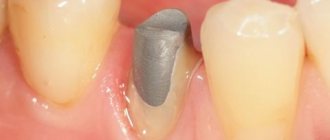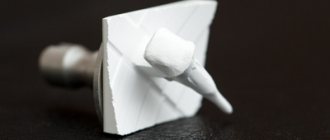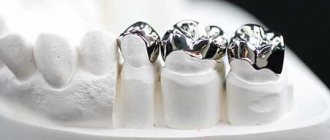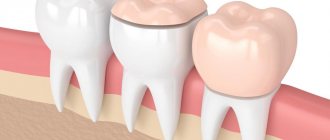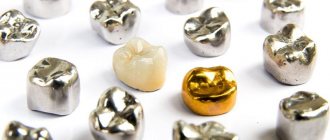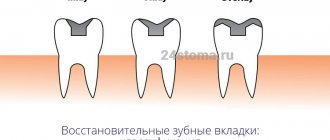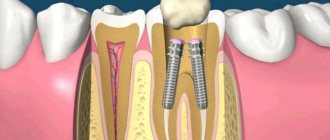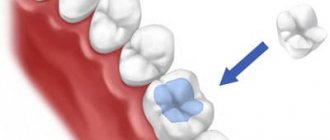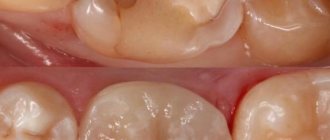If a tooth is destroyed by caries or as a result of injury, it must be restored, otherwise the tooth can be lost, and the absence of even one dental unit in a row is fraught with the most unpleasant consequences for health. For example, due to the absence of a tooth, an incorrect bite may develop, which leads to disruption of the correct process of chewing food and the development of various diseases of the digestive system.
If the tooth is slightly damaged, then most likely the doctor will use a regular, light-curing filling to restore it. But if the damage is significant, it would be more correct to use a stump tab.
Many people do not even know what kind of structure this is - a stump tab and for what purpose it is used by dentists. Meanwhile, the use of stump inlays makes it possible to successfully restore teeth that at first glance seem completely hopeless and must be removed.
In the article we will tell you in detail about what stump inlays are, what types of them exist, and why severely damaged teeth are best restored with inlays, and not with fillings and pins.
What is a stump tab and why is it needed?
A stump inlay is not a filling or a seal on a post. This is a specialized orthopedic design that is produced in a dental laboratory and is used to restore teeth that have been more than half destroyed by caries or trauma.
Of course, even a badly damaged tooth can be restored with a filling on a pin and then a prosthesis can be placed on it. But such an approach to prosthetics will be wrong, since large fillings, even if attached to pins, are simply not capable of holding well. The load on the tooth will sooner or later lead to the filling on the pin falling out along with the prosthesis, and then the tooth will have to be re-treated.
Stump inlays help to avoid such unpleasant consequences - they are firmly fixed in the root canal of the tooth and the dental crown is fixed on them. Externally, the inlays are very similar to stumps - ground teeth - hence their name.
What are the alternatives?
If there is a volumetric lesion of the coronal part of the tooth, there are only four options for prosthetics. The first is the tabs themselves. The second is filling, but a large filling may not withstand the load, and there will be too few tooth walls for the composite material to adhere to, so it will be short-lived. The third method is to install a crown. But this option is an extreme option, when other methods are no longer effective. The fourth method is tooth restoration on a pin: a metal rod is installed inside the root, which serves as a support for restoring the coronal part (using an artificial crown or composite build-up). This option is cheaper, but less durable, and the pin can lead to root fracture.
1 Shcherbakov A.S., Gavrilov E.I. Orthopedic dentistry. Ed. Folio, 1998.
Why are core inlays better than fillings and pins?
Fillings and pins are only applicable if the tooth has a sufficient amount of healthy tissue remaining. If only the root or thin walls of the tooth remain, then it cannot be restored with a pin, since such a restoration method will not be distinguished by either quality or reliability.
Firstly, under load, the pin can break and in the process damage the tooth root. Trauma to the root of a tooth is a direct indication for its removal; no methods for damaging the root system will help you save your tooth.
Secondly, dentures installed on large fillings and pins most often fall out some time after prosthetics. In this case, the treatment will have to be carried out again, and this implies new and significant financial costs.
IMPORTANT: Some dentists try to fix the fallen crown and pin with cement. But this is useless: the structure will not hold firmly, and in addition, an inflammatory process may begin under it, leading to rotting and destruction of the tooth.
Therefore, in case of severe tooth decay, only a stump inlay can provide high-quality and durable prosthetic results.
Features of the material
The use of light-polymer materials is gradually losing its relevance. This is explained by the fact that more advanced technologies using zirconium, titanium alloys, and ceramics are used for prosthetics.
Orthopedic inserts made from photopolymers are practically no different from fillings, except that they are made using a preliminary impression in the laboratory.
The main advantage of composite products is their tight fit, which prevents pathogenic microflora from penetrating deep into the root system, which provokes the recurrence of caries.
It should be noted that over time, the dental insert loses its natural whiteness and will stand out in relation to other units.
Types of stump inlays
Before installing a core inlay, it is imperative to treat the damaged tooth, remove all tissue damaged by caries, and also be sure to properly process and seal the root canals.
IMPORTANT: Root canal treatment is a process in which not the slightest mistake should be made! If the canals are treated poorly or improperly sealed, an inflammatory process may begin in them. In our dental clinic in Moscow - Firadent - treatment of tooth canals is carried out under a microscope, which allows the doctor to see the length and structural features of the canals and thus eliminate errors in the process of their treatment.
After treating the canals of the tooth, the orthopedic dentist begins to treat the patient: the specialist will unseal the canals to the length of the future stump inlay and take an impression for its manufacture. As we already wrote above, core inlays are produced in a dental laboratory.
There are several types of stump inlays. The classification of inlays is carried out according to the material of manufacture and the number of pins - fastenings with which the inlay will be firmly held in the tooth canals. The inlay may have several pins, their number is determined by the number of canals of the tooth being restored.
Based on the number of pins, the following types of stump inlays are distinguished:
- Single-rooted;
- Double-root collapsible and non-removable tabs;
- Three-root collapsible and non-removable stump inlays.
Multi-root inlays are most often made collapsible - this simplifies the process of securing the inlay in the tooth canals. But collapsible inlays are more expensive than non-demountable structures: the higher price is explained by the high complexity of manufacturing.
Materials for manufacturing pin stump inlays
Stump pin inlays can be made from different materials - ceramics or metal. Stump inlays with metal pins are most often made from an alloy of cobalt and chromium and are used for the installation of metal or metal-ceramic prostheses.
Cobalt-chrome core inlays have a number of specific advantages:
- They have good biocompatibility with human body tissues;
- Stump pin inlays made of this metal alloy fit quite tightly to natural tissues and therefore, when used, the risks of caries, inflammatory processes and further tooth destruction are reduced;
- Cobalt-chrome alloy has high strength and therefore a crown installed on a pin insert made of this material will not shrink during operation.
Stump inlays made of cobalt-chrome alloy allow for proper distribution of the chewing load, which reduces the risk of cracks and tooth destruction. The advantages of inlays made from this material include their affordable cost.
Ceramic pin inlays are used for the installation of metal-free dentures. This allows you to obtain impeccable aesthetics of the restored tooth. If you place a metal stump insert under the ceramic structure, it can be quite noticeable and, of course, it will spoil the appearance of the restored tooth. Therefore, only ceramic pin inlays are placed under ceramics.
What are the quality parameters of dental prosthetics with inlays?
If the technology was violated during the process of fixing the inlay, or the patient has not undergone preventive examinations for years, then secondary caries may occur at the border of the contact of the microprosthesis with the dental tissues. Then it will be necessary to carry out treatment and remove the dental inlay. At the same time, the design itself does not in any way stimulate the occurrence of caries. To avoid it, the main thing is to prevent technological inaccuracies during the installation process, so that the tightness of the dental inlay with filling the cavity with composite cement is equal to 0.004 microns. It is also important to ensure that there are no overhanging edges for a complete aesthetic and functional restoration of the tooth.
If the tab is installed correctly, then it does not provoke an increase in tooth sensitivity, and if not, then the antagonist tooth may begin to react to irritants due to malocclusion.
If pain occurs as a result of complications such as caries, pulpitis or periodontitis, the dental inlay must be opened and appropriate treatment carried out. After which this microprosthesis will need to be replaced with a new one.
How stump inlays are made: an overview of the main stages
Stump inlays are made individually for each patient. Treatment begins with an examination of the patient and consultation with two specialists – a general dentist and an orthopedic dentist.
Before an impression is taken from the tooth, according to which a stump insert will be made, high-quality sanitation of the oral cavity is carried out, and all diseases of the teeth and gums diagnosed during the examination are treated. The damaged tooth is treated: the nerve (pulp) is removed from it, and the canals are filled. This is where the work of the dentist-therapist ends and the orthopedist begins to care for the patient.
Further treatment will proceed according to the following scheme:
- The prosthetist will correctly prepare the tooth for installation of the stump inlay and select its type.
- When choosing the type of stump tab, the material of its manufacture and the type of tab (single-root or multi-root, cast or collapsible stump tab) are determined.
- Then the doctor will make an impression of the patient’s jaws, which will be sent to the dental laboratory, where a stump inlay will be made from the impression taken.
- Based on the impression, a model of the stump inlay is first made, and then a permanent structure is made from the selected material.
- The dental technician passes the finished stump inlay to the orthopedist.
After the stump inlay is ready, the patient is invited to the prosthetist’s office and the doctor installs the stump inlay in the tooth canals. A temporary prosthesis is put on the tab and a break is taken in the treatment until the crown is made, which the doctor fixes on the stump tab.
Review of composite inlays - purpose in dentistry, pros and cons, alternatives
Article navigation
- What are these structures?
- Materials
- Indications
- Contraindications
- Advantages and disadvantages
- Stages
- Complications
- Life time
- Care
- Alternatives
- Price
Question for a specialist
Dental inlays made of composite synthetic materials are considered an affordable and easy-to-manufacture solution for restoring teeth. But, at the same time, dentists rarely recommend their installation due to the large number of shortcomings of the material. Today we will talk about what a composite tab is, its pros and cons, in what situations it is used, and what alternatives there are.
Advantages and disadvantages of using stump inlays
The main advantage of stump pin inlays is the high reliability and durability of prosthetics. This design will firmly hold the installed dental prosthesis and, moreover, will allow for proper distribution of the chewing load. When using pin stump inlays, the risk of crown loss is reduced to zero.
Installing crowns on the stump inlay and pin allows you to increase the useful life of the prosthesis. In addition, core inlays help to obtain the ideal tooth shape and are suitable for restoration of anterior and chewing teeth.
There are only two disadvantages to the use of stump inlays - higher price and longer prosthetic time. On average, it takes about 2 weeks to make an inlay.
IMPORTANT: Only an experienced prosthetist can make a high-quality multi-root collapsible stump inlay. Therefore, it is so important to choose a clinic for your treatment that employs competent and qualified orthopedists and dental technicians and has its own, well-equipped dental laboratory. Our dentistry in Moscow, Firadent, 100% meets these conditions: your treatment with us will be carried out with impeccable quality and comfort!
When does a patient need a ceramic inlay?
If a patient needs to restore up to 50% of a tooth after treating extensive caries, filling canals, replacing old fillings, then he needs restoration with the help of a dental inlay - this is a guarantee of the durability of such treatment. A huge advantage of this technique is that it allows you to avoid depulping the tooth and installing a crown on it, thus preserving the “life” of the tooth and completely restoring its function and aesthetics. In most cases, chewing teeth are restored with inlays.
Are there any contraindications to the use of stump pins?
Unfortunately, not in all cases, stump pin inlays can be used for dental prosthetics.
Stump inlays should not be used under the following circumstances:
- When a tooth is destroyed below the gum level;
- When the quality of root canal filling is poor. In this case, it is necessary to unseal the canals, reprocess and seal them, and only then install a pin stump inlay and crown;
- A contraindication to the use of a pin stump insert would be an inflammatory process in the area of the tooth root;
- Allergy to the materials used to make the stump inlay on the pin.
Also, inlays are not placed on loose and mobile teeth.
IMPORTANT: In some cases, a stump pin can still be installed even if the tooth is destroyed below the gum level. But this will first require an additional operation - an osteotomy. The essence of this operation is to cut down the bone tissue to such an extent that the gum is below the destroyed tooth.
Indications and contraindications
The effectiveness of composite inlays will be noted in the following cases:
- if there is a loss of more than 60% of a tooth;
- the large size of the carious cavity, which makes it impossible to install a conventional filling;
- to prevent thinning of the enamel of the upper and lower jaw rows;
- if necessary, strengthen the abutment tooth for installation of a bridge;
- with bone tissue dysplasia, hypoplasia of the surface enamel or in the presence of a wedge-shaped defect;
- for sealing the fixation of removable dentures.
Situations that make it impossible to use this type of orthopedic structures include:
- rapid progression of caries (circular or cervical form), and the presence of large chips with significant destruction of incisors or molars;
- lack of proper oral care;
- grinding teeth during sleep (bruxism);
- diseases that cause mental impairment.
Dental care after the installation of a core tab
Stump inlays do not require complex specific care. All you need to do is maintain oral hygiene, brush your teeth regularly and undergo periodic dental examinations and professional hygiene procedures.
To clean crowns installed on teeth with core inlays, it is best to use brushes with soft bristles; it will also be useful to rinse your mouth after each meal - with a special balm or just clean water. When brushing your teeth, it is important to clean them from all sides and be sure to thoroughly clean the interdental spaces. For this purpose, special brushes and dental floss are used.
Alternative prosthetic options
Currently, dentists practically do not use composite materials for inlays. Or they are used, but only for temporary restorations. Because there are other, much better materials. The best alternative to composite is ceramics (pressed, leucite glass ceramics or materials based on lithium disilicate), as well as the strongest aluminum and zirconium dioxides. Ceramics are considered the best in terms of aesthetics, and they will last at least 10 years. Zirconium dioxide and aluminum oxide are slightly less aesthetically pleasing (but this drawback can be solved with the help of facing materials), but they have the longest service life - from 20 years.
Prices for stump inlays
How much does a stump tab cost? Prices for stump inlays can vary greatly: the main influence on the cost of the structure will be exerted by the material of its manufacture. The most budget option is metal stump inlays. A simple non-removable (cast) metal stump inlay costs about 5,000 rubles. A collapsible multi-root metal stump inlay will cost a little more - from 6,000 rubles and more.
Ceramic and zirconium stump inlays have the highest prices. Their cost starts from 8,000 rubles.
IMPORTANT: The cost of making a core tab does not include the cost of installing a crown! Dental treatment, canal filling, production and installation of a crown are paid separately!
Service life and cost
Restoration of teeth using composite inlays is a common and inexpensive procedure.
This technique is popular among part of the population experiencing financial difficulties, and is often the last chance in an attempt to restore the integrity of the tooth.
The service life of microprostheses made of light-polymer materials on average does not exceed 4 years. This is much less when compared with models made of gold, titanium alloys (from 10 to 20 years) or porcelain (up to 15 years).
To maximize service life, you must adhere to the following rules:
- clean the oral cavity at least twice a day using hygienic pastes;
- after eating during the day, use dental floss or rinses and elixirs;
- perform ultrasonic whitening at least once a year;
- visit the dentist’s office at least twice a year;
- At the first symptoms of caries, provide timely treatment.
The average cost for this type of product is within 4,000 rubles. This is significantly lower than the price of ceramic structures, which have a starting price of 8,000 rubles, and zirconium products have a cost starting from 17,000 rubles.
The video provides additional information on the topic of the article.
What to choose when doing prosthetics - restoring a tooth with a core tab or a filling?
What to choose when installing a crown - restoring a tooth with a core inlay or a filling? This question is often asked to doctors by patients who decide to restore their teeth. This question can be answered this way: if your tooth is badly damaged, and you want the installed crown to serve you for as long as possible, it is better to choose not a filling, but a stump inlay.
Yes, prosthetics with a stump inlay will be more expensive than installing a crown on a regular filling, but all costs will be repaid by the long useful life of the prosthesis and the high quality of the prosthetics. Stump inlays allow you to save and successfully restore even the most hopeless teeth!
If you still have questions about stump inlays, you want to find out their exact cost and find out the possibility of using a stump inlay in your case - come to an appointment with specialists at our dental clinic in Moscow - “Firadent”! We will be happy to help you achieve a new beautiful smile with healthy teeth!
Reviews
Based on the presented material, we can conclude that sometimes there comes a time when the only correct way to repair the damage is a composite inlay.
If you have undergone the procedure of installing dental composite inserts or would like to share information about their use, as well as your impressions, please leave feedback on this article in the “comments” section.
If you find an error, please select a piece of text and press Ctrl+Enter.
Tags prosthetics tabs
Did you like the article? stay tuned
No comments yet

